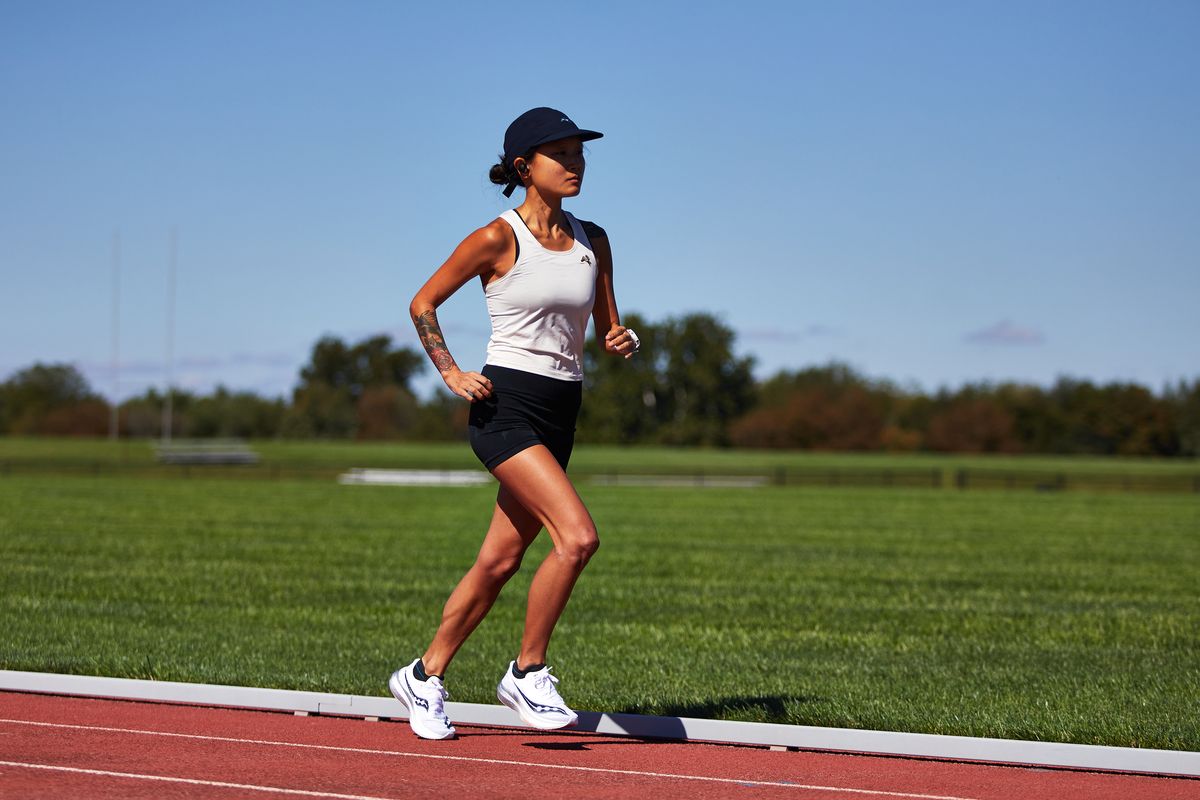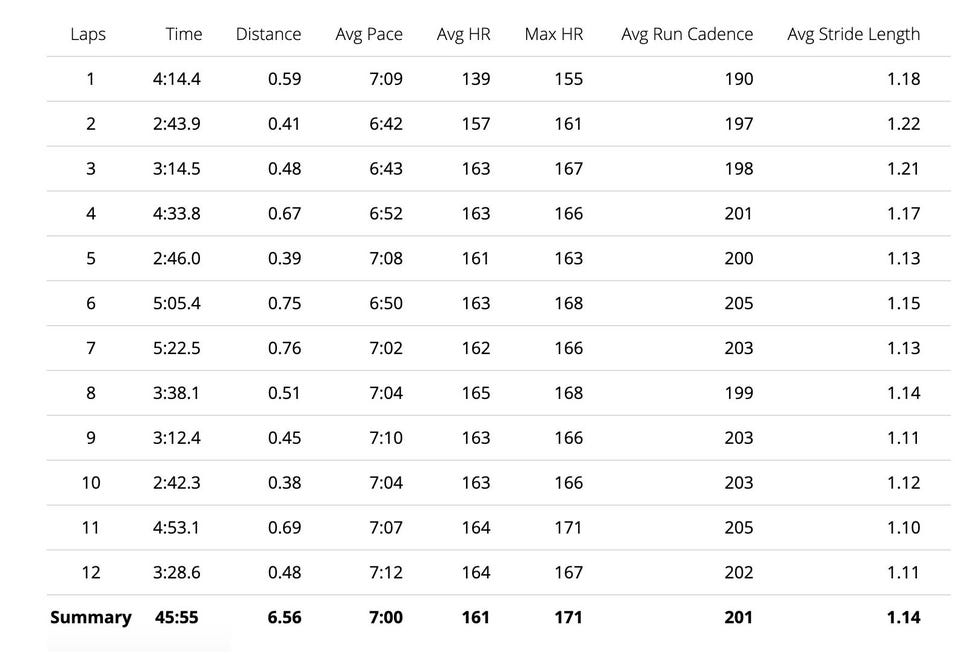“Can a song’s tempo change your pace as you run?” In a small study published in the Journal of Strength and Conditioning Research, results were surprising. Brazilian researchers found that music-free runners’ times weren’t significantly different compared to those who listened to music while running a 5K.
In my mind, there are two kinds of runners: those who listen to music and those who somehow can tolerate the sound of their own breathing and footfalls during a workout. I hated running in high school, tolerated running in college, and finally found the missing ingredient that allowed me to enjoy runs beyond three miles: music. I discovered I could create my own personal soundtrack for wherever I ran.
We wanted to test whether I ran faster because of the tempo of a song, or beats per minute (bpm), by measuring my cadence, pace, and other stats.
More From Runner's World

The Test
For a true song/tempo test I needed to run into it “blindly.” Senior test editor Jeff Dengate compiled a—very folksy—playlist of music I don’t normally listen to, which I synced to my Garmin Forerunner 745.
The Playlist:
- “I Need Never Get Old,” Nathaniel Rateliff | 135 bpm | 4:13 duration
- “The Body Electric,” Hurray for the Riff Raff | 92 bpm | 2:49 duration
- “The ’59 Sound,” The Gaslight Anthem | 168 bpm | 3:09 duration
- “Give It Up or Let Me Go,” Bonnie Raitt | 100 bpm | 4:29 duration
- “Harlem River Blues,” Justin Townes Earle | 156 bpm | 2:48 duration
- “Fish and Bird,” Noam Pikelny | 93 bpm | 5:13 duration
- “Henry,” Keb’ Mo’ | 82 bpm | 5:18 duration
- “Johnny 99,” Bruce Springsteen | 158 bpm | 3:38 duration
- “Birds on a Feeder,” Kathleen Edwards | 84 bpm | 3:13 duration
- “Cheap Sunglasses,” ZZ Top | 94 bpm | 2:40 duration
- “Ruby,” Dave Rawlings Machine | 120 bpm | 4:54 duration
- “Bad Self Portraits,” Lake Street Drive | 168 bpm | 3:24 duration
I ran on an outside track to ensure the course would be flat and consistent. I recorded a split for each song using the lap function so it would be easy to compare stats post-run. The total runtime of the playlist was 45:48, with a total of 12 songs. I set up some rules to follow before proceding:
- No shuffling the playlist
- No skipping ahead (no matter how tempting)
- No looking at my pace
Want to give the RW Test Playlist a go? Tell us about your test run in the comments below.
Check out this month’s RW playlist and more, here.
Field Notes On Select Songs
Song 1: “I Need Never Get Old,” Nathaniel Rateliff & The Night Sweats
135 bpm | duration: 04:13
Distance: 0.59 mile
Avg pace: 7:09
Avg HR: 139 bpm
Avg cadence: 190 spm (strides/minute)
Avg stride length: 1.18m
I get this creeping anxiety when I step onto a track because of my very-nonathletic high school days. Anything less than a 5K I avoid. Anything longer than a 5K on a track—forget it. Because of my oval-repulsion, this was an ideal first song. In their study, researchers’ categorized warm-up music as 110 to 150 bpm, slow music as 80 to 100 bpm, fast 140 to 160 bpm, and calming post-run music 95 to 110 bpm. Considering these measurements, “I Need Never Get Old” had the perfect average bpm to kick-off my one-person parade. Come at me, oval.
Song 2: “The Body Electric,” Hurray for the Riff Raff
92 bpm | 02:49 duration
Distance: 0.41 mile
Avg pace: 6:42
Avg HR: 157 bpm
Avg cadence: 197 spm
Avg stride length: 1.22m
Surprise! Even though this song was only 92 bpm, I ended up running my fastest pace. Mostly because I really liked this one. Granted, a sardonic smile was plastered on my face as I privately thought, “Why did Jeff choose a song about a woman getting murdered?” It’s so shocking but dreamy: “he’s gonna shoot me down/put my body in the river/cover me up with leaves of September.” I don’t know what this says about me (apparently frontwoman Alynda Lee Segarra wrote the song as a critique of murder ballads by singing the story through the lens of the victim; the result is haunting and badass), but I added it to my personal rotation. It just made me soar—literally. My average stride length was the longest compared to all the other songs’ stats.
Join Runner's World+ for unlimited access to the best training tips for runners
Song 3: “The ’59 Sound,” The Gaslight Anthem
168 bpm | 03:09 duration
Distance: 0.48 mile
Avg pace: 6:43
Avg HR: 163 bpm
Avg cadence: 198 spm
Avg stride length: 1.21m
This sounded like The Killers. I really wanted to rock out. I could feel my hips swaying down straightaways and I really wanted to play air guitar. But I was on a mission, and there was no time for an air strumming solo. I ran my second fastest pace. “The ’59 Sound” has the highest bpm on this playlist, tying with Lake Street Dive’s “Bad Self Portraits” (song 12).
Song 7: “Henry,” Keb’ Mo’
82 bpm | 05:18 duration
Distance: 0.76 mile
Avg pace: 7:02
Avg HR: 162 bpm
Avg cadence: 203 spm
Avg stride length: 1.13m
This blues track felt like it’d go on forever. I hadn’t looked at each song’s duration before my run but, wouldn’t you know, this was the longest one on the playlist. At 82 bpm, it was also the slowest. Despite its reduced tempo—or because of it—my pace was closest to the average pace overall (seven minutes). I had this bizarre notion that the faster I ran the quicker the song would be over, because that’s how running with music works. (I know it doesn’t, but I call this “runner mind tricks.”)
Song 12: “Bad Self Portraits,” Lake Street Dive
168 bpm | 03:24 duration
Distance: 0.48 mile
Avg pace: 7:12
Avg HR: 164 bpm
Avg cadence: 202 spm
Avg stride length: 1.11m
“Bad Self Portraits” sounds like a sitcom intro. It has the highest bpm, 168, tying with “The ’59 Sound,” but the song didn’t sound fast-paced. Most of it was carefree; the verses had a happy-go-lucky feel. I imagined an eighties montage of childhood photos with credits in an ITC Serif Gothic Bold font (I clearly grew up watching Growing Pains marathons). It was the last song on this playlist but I wouldn’t say its rhythm inspired a sprint to the finish. I ran my slowest pace during this song. By the time the beat picked up, with “hoo-ooh” announcing each refrain, I just wanted this experiment to be over.
Results
Combing through my overall results—average pace 7 minutes, average heart rate 161, average cadence 201, average stride length 1.14—my stats for each song were pretty consistent. My stride length was slightly wider during the first four songs, but I fell into a groove that was surprisingly unaffected by the bpm sent to my ears.
As a test subject, I had a preconceived notion of the task at hand, which likely impacted my run and results. If a slow song played after a fast one, I fought the urge to slack off and kept the pace. When Bonnie Raitt’s “Give It Up or Let Me Go” (song 4) came on, my head was slightly nodding to the beat. That brass band was an assault on my upper body. I had to control it or I’d burn out before hitting the midway point of the playlist. Songs like Noam Pikelny’s “Fish and Bird” and Kathleen Edwards’s “Birds on a Feeder” were so darn thoughtful, that I purposely powered through them, my fists practically punching the air so my form wouldn’t become lax.
Jeff conducted an abbreviated test on the road, listening to 10 out of the 12 songs on shuffle, plus an ad since he doesn’t have Spotify premium. Because it’s his playlist, I figured he’d have an advantage, preparing for hard efforts to match the uptempo portion of each song. Where I resisted, I predicted he would embrace the softer melodies, slowing his pace, enjoying his music, not feeling entrapped by the oval or apprehensive of what would play next.
My prediction was semi-correct. During mellower songs like “The Body Electric” and “Fish and Bird” his pace was 10 seconds slower per mile compared to his pace during other songs.
“I really felt slower in real time,” he said. “I didn’t feel like I was working any less hard, but thought maybe I wasn’t turning my legs over quite as easily as before...I love those songs, but I’ll skip them if they ever come up in my random mix on runs.”
Like my pace listening to “The Body Electric,” Jeff found he ran faster to “Cheap Sunglasses,” which is only 94 bpm. “It’s not a super high energy song, but it’s funky, fun, and got me going,” he said.
The Takeaway
This test is small-scale, and the kind of thing us runners take on as a whim when someone asks a random question during a group run. Does a song’s tempo affect performance? Meh, slightly.
Our stats also aligned with the Brazilian researchers’ findings: the higher your effort level, the less effect music has on performance. “Initially, participants were affected by music since they needed a time period to process all afferent information regarding peripheral receptors. As soon as the brain realized the exercise intensity, a mechanism called attentional switching occurred by directing attention to the most important signals."
Neither I nor Jeff recorded the same run without listening to music, so we had no control experiment as a comparison—and I really didn’t want to run another 45-minute track session. Other variables to consider are our overall health and fitness levels, the weather, and amount of sleep we had the night before, or lack thereof. Besides the playlist, all of the above also had some influence on our performance. We’re merely runners and, alas, only human.
So what’s our verdict? Simply stated—and I’ll admit it’s not the most satisfying answer—what we listen to and how it makes us feel on a run is purely dependent on the individual.
Maybe a sweet and dark little diddy about murder rouses an energized run. Or ZZ Top singing about rhinestone shades lengthens your stride and quickens your pace. Oh yeah/oh yeah/oh yeah.
“I think that’s one takeaway I like about this,” Jeff said. “It’s that songs we like, even if they’re not formulaic performance enhancers, can change our energy.”
Amanda is a test editor at Runner’s World who has run the Boston Marathon every year since 2013; she's a former professional baker with a master’s in gastronomy and she carb-loads on snickerdoodles.















